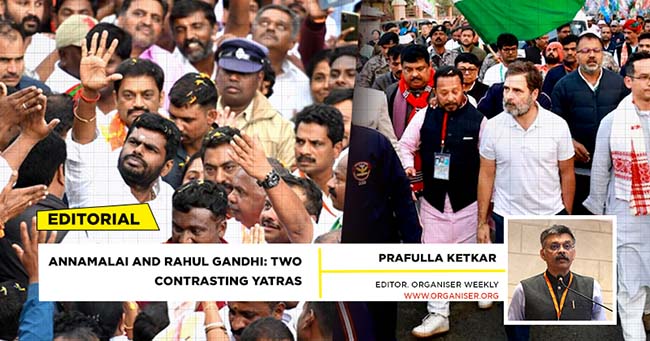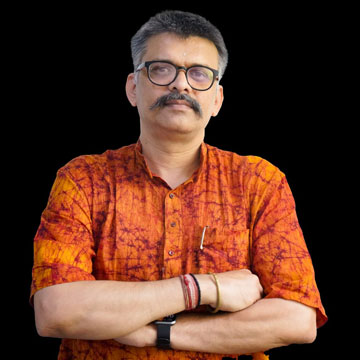“Formerly I thought as every Hindu thinks, and as the Hon. President has just pointed out to you, that this is the Punya Bhumi, the land of Karma. Today I stand here and say, with the conviction of truth, that it is so. If there is any land on this earth that can lay claim to be the blessed Punya Bhumi, to be the land to which all souls on this earth must come to account for Karma, the land to which every soul that is wending its way Godward must come to attain its last home, the land where humanity has attained its highest towards gentleness, towards generosity, towards purity, towards calmness, above all, the land of introspection and of spirituality — it is India”. –Swami Vivekananda, CWSV ,Vol III,Lectures from Colombo to Almora, First Public Lecture in the East on January 15, 1897.
Yatras, or embarking on the journey with purposeful intent, has a unique spiritual and religious significance in Bharat. In the political realm, these Yaras have also been used to connect with people and spread the political message. From Mahatma Gandhi onwards, many political leaders have used Yatras as a tool of mass mobilisation. In recent months, two Yatras have made the headlines – one by Rahul Gandhi’s Bharat Jodo Yatra and its continuation as Bharat Jodo Nyaya Yatra and K Annamalai’s, the President of BJP’s Tamil Nadu unit, En Mann, En Makkal (My Land, My People) Padayatra. As the General Elections are approaching, it is interesting to compare the intent, content and impact of both Yatras.
Rahul Gandhi started the first phase of his Yatra on September 7, 2022, from Kanyakumari in Tamil Nadu. He ended it in Jammu-Kashmir to fight against the politics of “fear, bigotry and prejudice”. The second phase, Bharat Jodo Nyay Yatra, started on January 14, 2024, from Thoubal in Manipur and is expected to end on March 20, 2024, in Mumbai. This leg of Yatra aims to ‘unite India through justice’. Though claimed to be non-political, each point made during the Yatra is political with the rhetoric of ‘anti-people policies of the current Central Government’ from conducting caste census to assuring the legal right of Minimum Support Price (MSP) to farmers all promises made as part of ‘Bharat Jodo’ and ‘Nyay’ to the people.
Though restricted to Tamil Nadu, K Annamalai embarked on the My Land, My People Padayatra with a clear objective of reaching out to every assembly constituency of the state. The Yatra was started on July 28, 2023, and culminated with a massive rally addressed by Prime Minister Modi on February 27, 2024. The objective was to ‘reclaim the lost glory of Tamil Nadu’ and provide an alternative to the Dravidian model of politics infested with negativism and dynastic corruption. His main aim was to connect with the masses, take his party to every corner of the state and speak on the issue of delivery-based governance.
When conceptualising such mass connect programmes, proper preparation is necessary. From the objectives, it is clear that Rahul Gandhi’s Yatra lacked clarity of objectives; hence, he has been reacting to the ongoing issues, meeting the wrong people contrary to the state’s objectives and insulting the local people with derogatory words. Talking about a caste-based census or lack of participation of the ninety per cent population in the decision-making process is fine, but how can Rahul Gandhi get rid of the responsibility of such a situation with his party and family ruling the country for more than sixty years? Addressing the baggage issue of dynastic corruption was never considered while conceiving the Yatra. In his corner meetings, he seems to preach or accuse somebody. The organisational machinery is not there to support the exercise, hence the takeover of Yatra by a coterie of advisers with their agenda.
On the contrary, Annamalai is challenging the establishment on a clean slate and with the track record of Modi’s delivery on the ground. His approach is not of entitlement or arrogance but of human touch and listening. His entire party machinery worked with the same objective and spirit; as a result, the culmination is seen as the political storm in Tamil Nadu politics.
In any political communication, there would be some element of sloganeering and rhetoric to connect with the people; still, it has to be backed by substance. Annamali’s expose of DMK’s corruption files, his leadership during the Chennai floods, and his positive message of making Tamil Nadu part of Bharat’s success story resonated with the masses. His approach provides an alternative to the establishment. Rahul Gandhi, on the contrary, looks to claim for entitlement. The impact of these yatras will be directly proportionate to the intent and content. The conviction and commitment required for the people and cultural edifice of the nation are critical while embarking on the Yatra. While employing modern communication techniques, Annamalai relied on this ancient wisdom, but Rahul Gandhi seems to have missed it.




















Comments